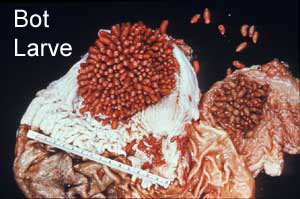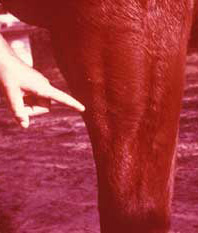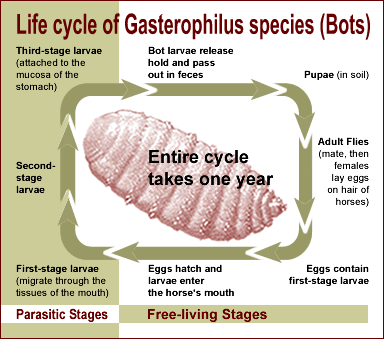Internal parasites are small organisms that live a portion of their life cycle in a host animal. They live in internal organs, body cavities, and tissues while gaining their nutritive source by feeding on the host animal. The horse is affected by many different species of parasites. The nature and extent of damage varies with the parasite.
Parasite infestation causes loss of nutrients or blood from the host, resulting in serious medical problems. Horses heavily burdened with parasites will have a loss of condition due to a depletion of nutrients and blood, decreased growth, and reduced reproductive and athletic performance.
Numerous internal parasites infect horses, but there are only a few that commonly cause significant health problems. To establish an effective parasite control program, it is important to first understand the life cycle of parasites. Successful prevention and control programs are effective because they interrupt the life cycles of parasites. In some areas of the country, the primary class of internal parasites that cause health problems for horses are nematodes, such as large and small strongyles, ascarids, and tapeworms. Other internal parasites perhaps of lesser significance, such as pinworms and botfly larvae, are often considered when designing a parasite control program.
Stomach Bots
Stomach bots are not worms but, rather, the larvae of the botfly, Gasterophilus. Female botflies lay their eggs by attaching them to the hairs of the horse. Different species lay their eggs on different parts of the horse’s body. Gasterophilus nasalis lay their eggs between the jaw bones. Gasterophilus hemorrhoidalis lay their eggs on the short hairs of the lip. Gasterophilus intestinalis lay their eggs on the forelimb and shoulder.
The eggs on the legs are stimulated to hatch by the lip action and warm saliva as the horse licks its leg. Those seen around the nostrils and lips hatch spontaneously in a week to one-and-a-half weeks. Larvae attach and burrow into the tongue and gums of the mouth and incubate there for three weeks. After incubation, they are swallowed and attach to the lining of the stomach. Bots spend approximately nine months attached to the stomach lining before passing out with the manure. These larvae pupate into adult flies. The life cycle depends on the parasite larvae overwintering in the stomach, then passing out in the manure in spring and subsequently developing into adult flies.
The adult flies are active from late spring to the killing frost in the late fall. Botflies have no trace of mouth parts and never feed. They live their adult life cycle on stored energy. They have yellow stripes and resemble a sweat bee.
Botfly larvae probably cause minimal damage to the stomach but can cause damage to the lining of stomach and cause outflow obstruction. However, until these parasites are proven not to cause damage, their control should be considered in any parasite control program.
Craig Wood, University of Kentucky





